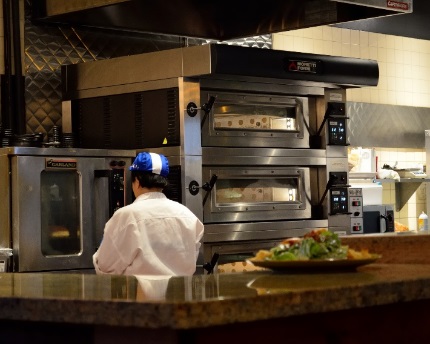
Exhaust Hood Controls
Ventilation can account for up to 29% of a kitchen’s energy bill. Per square foot, restaurants use about 2.5 times more energy than other commercial buildings. Kitchen exhaust hoods are important for removing heat, smoke, odors, and particulates from the cooking area to prevent them from exiting the kitchen and infiltrating other areas of the building, such as the dining room. It is critical to have a well-ventilated kitchen, combined with an efficient HVAC system, for employee and patron safety and comfort.
Exhaust hood fan motors without controls usually run at full speed, even during times when little to no cooking occurs. When kitchens are less busy, exhaust hood motors need not run at full speed. Specialized exhaust hood variable-speed drives (VSDs) can be installed on exhaust fan motors, as well as the makeup air unit, to regulate the speed of the fans based on the temperature, smoke, and/or air quality in the exhaust hood. Using sensors, VSDs adjust the speed of the exhaust fan motor. This simple upgrade can reduce energy use between 20-50% for this specific measure, while quieting operations during slower periods.
Exhaust hood controls also reduce maintenance costs in a few different ways:
- Slows down the motors to reduce wear and tear
- Reduces the amount of makeup air required to be brought into the space and conditioned
- Lessens the strain on the heating and cooling system
- Slows down the motors, allowing the grease to flow back to the hood to collect in the grease cups, rather than it remaining in the ducts and exhaust
- Reduces the frequency with which the system must be cleaned
Customers who make upgrades with energy efficient exhaust hood controls typically see a return on investment in less than two years. Types of businesses that benefit from exhaust hood controls include:
- Private restaurants
- K-12 schools/higher education
- Office Buildings
- Hotels
- Hospitals
- Assisted living facilities
- Other food services
Laboratory Fume Hoods
A laboratory fume hood exhausts potential hazardous fumes and particulates from the laboratory. Proper ventilation of the laboratory is required to maintain adequate air pressure and airflow rates to exhaust fumes and particulates, and to ensure they do not reenter the room. Depending on the type of lab, different levels of air change per hour (ACH) are mandatory to ensure proper ventilation. Typical labs in colleges and universities, for example, require an average of 4 to 6 ACH per hour.
When fume hoods are in use, a typical face velocity—or speed of the air—of approximately 100 feet per minute (FPM) of exhausted air is required. In many cases, however, when fume hoods are not in use, they maintain the same face velocity, using more energy than needed. Best practices dictate monitoring the occupancy around the fume hood and reducing the face velocity to the minimum requirement of 60-80 FPM, minimizing amount of air being exhausted when a space is unoccupied.
Automatic Sash Controls
Automatic sash controls close the sash on the fume hood automatically. Often, operators leave the sash open, even when the fume hoods are not in use. This common practice increases the amount of energy wasted through the fume hoods. Simple installation of automatic sash controls on fume hoods can increase the amount of energy saved by up to 30 percent.
VSDs on Lab Exhaust (Strobic) Fans
Lab exhaust fans are designed to exhaust air from the fume hoods and the labs at a high pressure to dilute fumes in the atmosphere and reduce air contamination. Typically, they are set at a high pressure setpoint and run at full load all the time. Variable speed drives (VSDs) can be installed on the exhaust fans to vary their speed while maintaining the required air pressure setpoints.
Temperature Controls in the Lab
Many labs are set to a constant temperature throughout the year to maintain a specific environment for experiments and working conditions. Labs that do not require strict temperature regulation, however, do not require a constant temperature setting during unoccupied time. Temperature control setback/setforward during unoccupied time reduces the thermal/electric loads needed to heat or cool the makeup air introduced in the labs.




